#cats warsaw portraits
Text


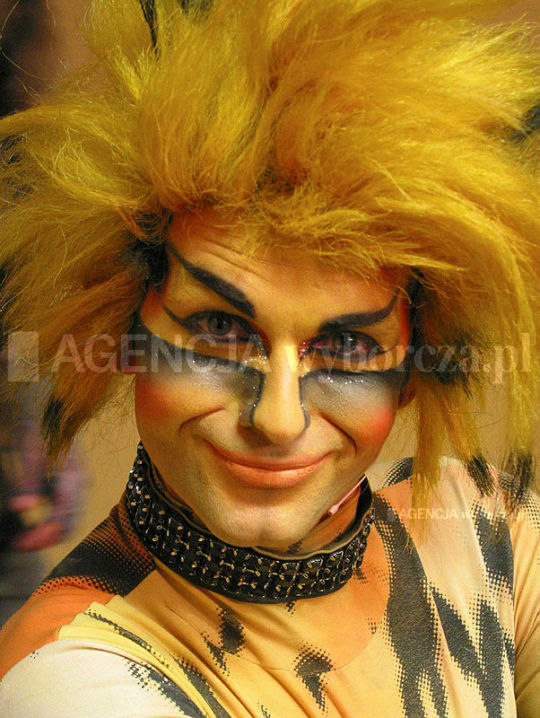
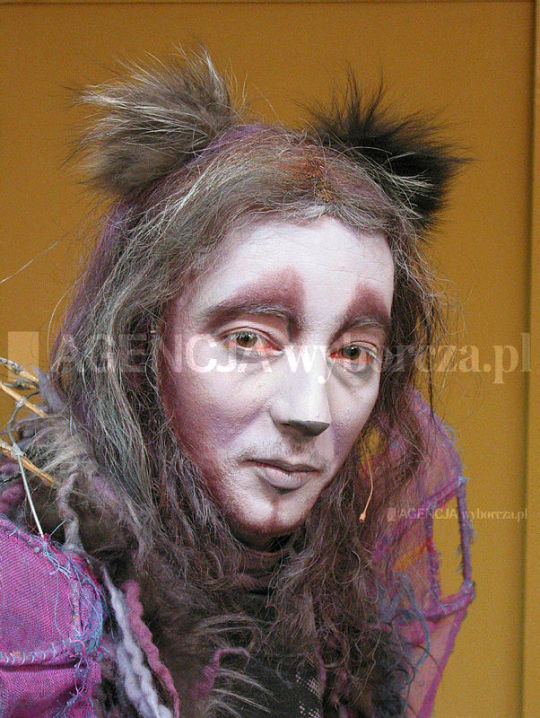
Cats Warsaw portraits pt. 6
Katarzyna Gaweł-Stańkowska as Kasandra [Cassandra]
Wojciech Paszkowski as Kot Bywalec [Bustopher Jones]
Paweł Strymiński as Mungojerrie
Tomasz Steciuk as Gus
Photos taken before one of the preview shows
January 7, 2004
Photos by Grażyna Jaworska
#cats the musical#cats warsaw#koty musical#kasandra koty#cassandra cats#katarzyna gaweł-stańkowska#kot bywalec#bustopher jones#wojciech paszkowski#mungojerrie#paweł strymiński#gus the theatre cat#tomasz steciuk#cats non replica#cats warsaw portraits
44 notes
·
View notes
Text
Cats Warsaw Merch
Aka all the Cats Warsaw merch things that I've found, at least so far
Starting with the stuff that I actually own:
CD Album

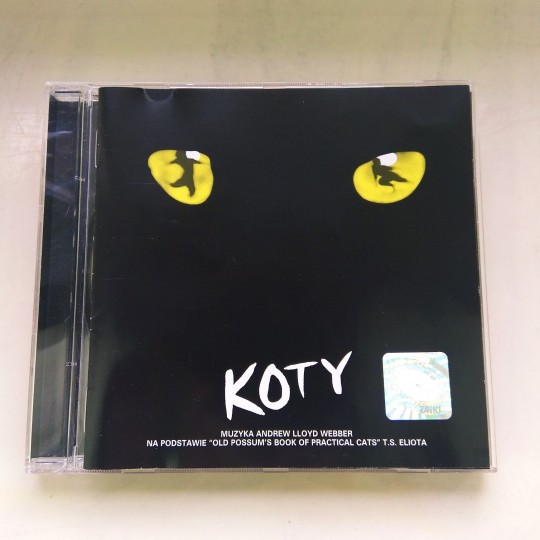
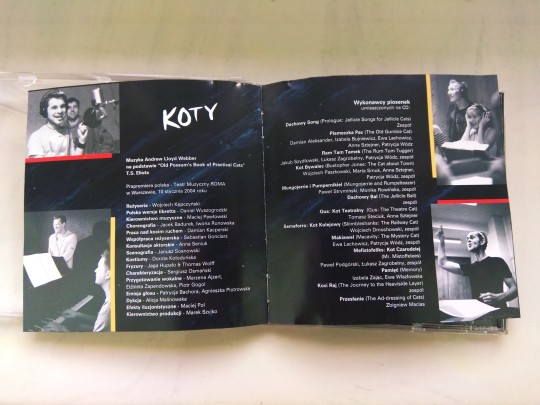

It's a highlights album containing 14 of the songs, sang by the main singing part of the cast, which mainly results in that some parts go to different people than later on stage, including Mistoffelees' part in "Mr M" being sang by the actor playing Victor (he does sing it as Misto). Also some of the songs in their arrangements are sounding closer to OBC than to how they would later sound on stage (mainly Jellicle Ball and Mr M).
The little booklet contains some basic information about the show, the songs included and the cast, as well as a few photos from the recording of the album
It was recorded in November 2003 and published/available for purchase with the premiere of the show on Jan 10, 2004
Programme
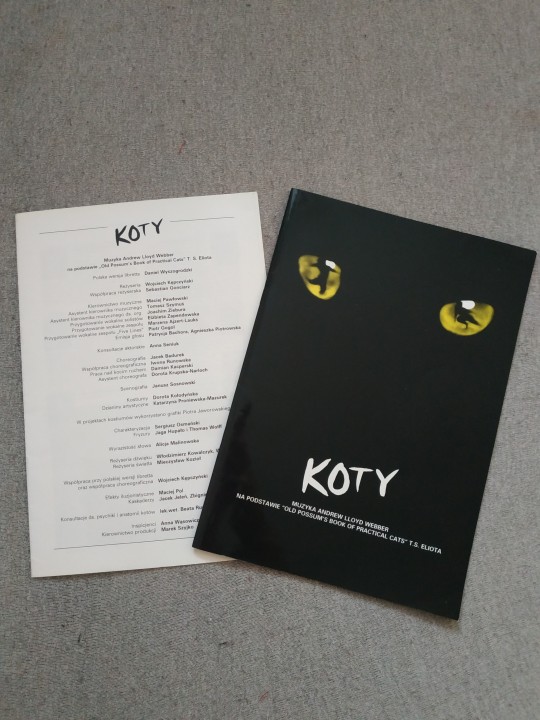
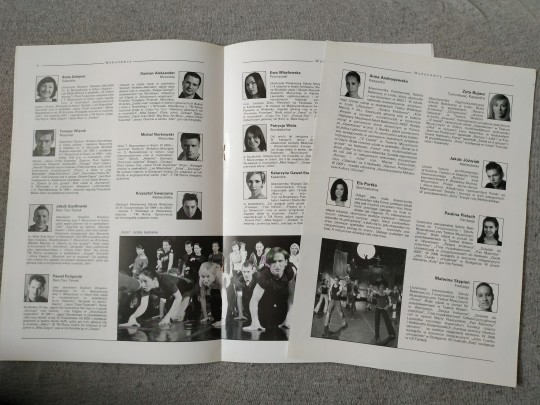
I got actually 2 of those, from 2004 and 2007. They are almost identical (only differences are ads and a bracket indicating one of the sponsors died by 2007). The actually different things are the cast inserts, both in the cast as well as the general formatting and rehearsal photos included
More photos of the 2004 version here
Book

Once again I have 2 of those, one came to me in its original protective sleeve and i'm keeping it safely tucked away. The other one is by now ever so slightly falling apart from how many times I've read it XD


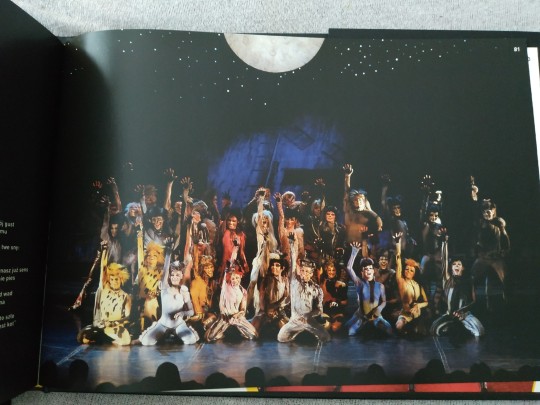
The book contains interviews with: the set, costume and make up designers, the translator and some notes from the choreographers and cast members. It also includes quite a few photos (most of them from rehearsals) as well as fragments of song lyrics, some of the character descriptions and other general information about the show and its production
It was published in November 2004
Stuff that I know about from photos
Posters
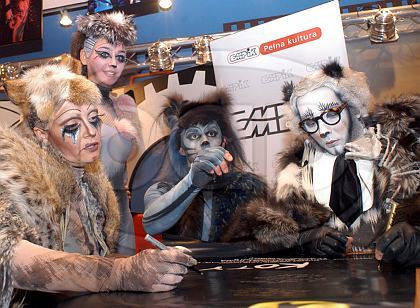
I have a few such photos from a promo event for the CD album where people could get cds and posters, get them signed and there was face painting and some other activities including learning how to be a cat or smth
Umbrellas
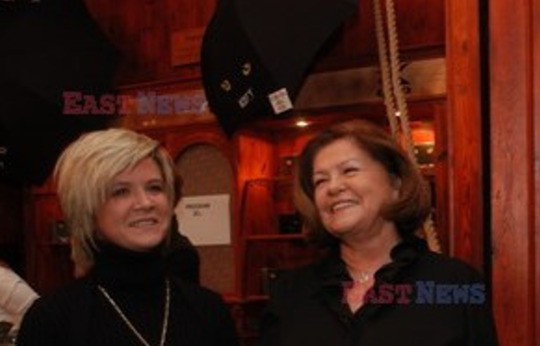
This premiere photo is the only one that I got
A cup and a saucer

This is the only picture I have of it, and I am honestly not sure if it was actually sold or if it was custom made, but I'm gonna count it anyway
Pens

I don't actually have a photo of any, BUT the plaque over this lady's shoulder says "Długopis KOTY" aka "Pen CATS", and at this point that's all that I got (also there are CD albums on the top shelf)
Repertoire brochure
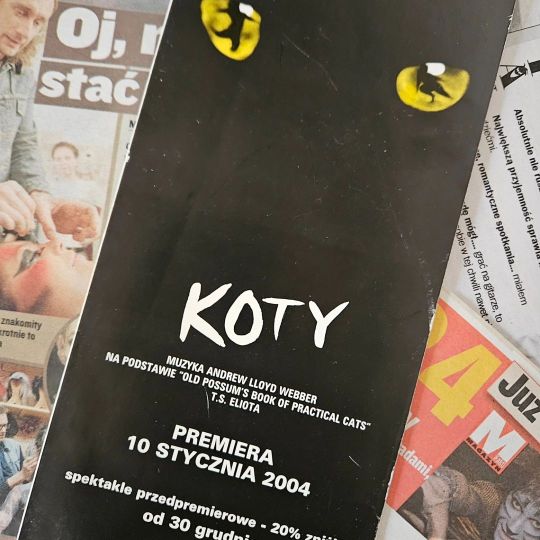

Distributed most likely sometime in December 2003, given it advertises the premiere and all the preview shows. Cats Warsaw had in total 6 preview shows, and it also had 2 premieres
The repertoire is for January and Febuary 2004, aka the original planned run of the show
Calendar

This is the only photo I have of it, possibly for June or July page, and curiously enough the same photo can be found in the Warsaw book, on Demeter's page. This suggests at least some other portrait photos from the book were originally taken for this calendar
Not merch but I thought they should be included
Cats Warsaw documentary "Ujarzmić Koty" ("The taming of Cats")

Making of Cats Warsaw, which included some of the musical's history and the director's history with it; some interviews with the cast, mainly Damian Aleksander (Munkustrap), Ewa Lachowicz (Demeter), Grzegorz Suski (Macavity), Jakub Szydłowski and Paweł Podgórski (both Rum Tum Tugger); rehearsal, backstage and premiere footage
It had its premiere on December 20, 2004
2005 edition of the Poems (that I do own)
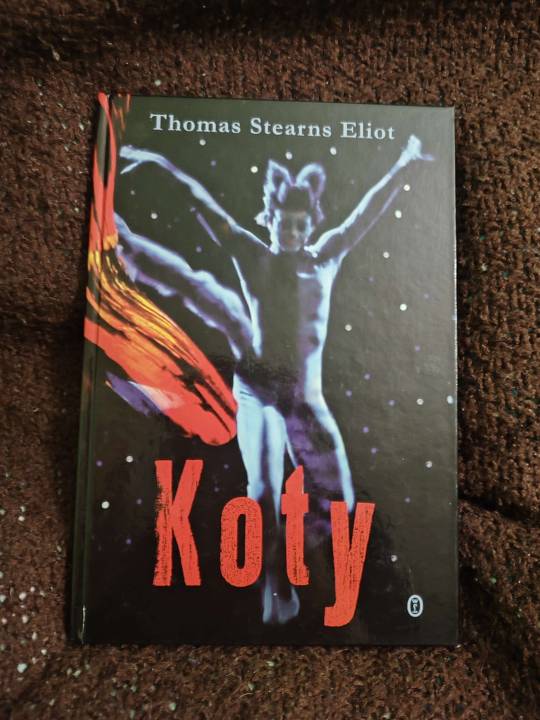
2005 edition of "Old Possum's" translated by Stanisław Barańczak, simply titled "Koty" ("Cats")

The only tie it has to the musical is the fact that the cover photo is a very edited fragment of a rehearsal photo featured in the middle spread of the programme mentioned in the beginning of this list
It's Tantomile plus Etcetera's leg
#and that's it#that's all the cats warsaw merch that i'm aware of#i believe there might have been some postcards or other small things too but i have zero solid proof of any kind#cats the musical#cats warsaw#koty musical#cats the musical merch#cats warsaw merch#jellicle cats#cats non replica
20 notes
·
View notes
Video
The male lion walking in his enclosure by Tambako The Jaguar
Via Flickr:
The male lion of the Warsaw zoo walking in his enclosure...
#lion#big#wild#cat#male#portrait#face#mane#walking#grass#vegetation#looking#warsaw#zoo#poland#nikon#d5
55 notes
·
View notes
Photo

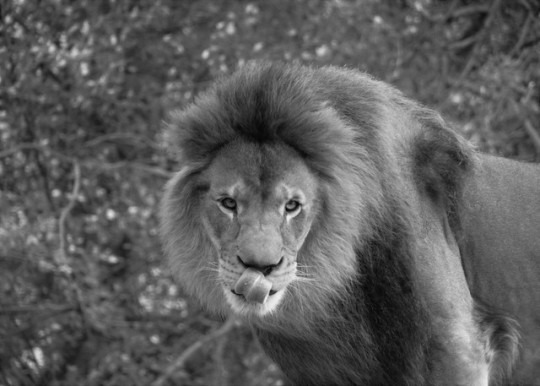
he looks… hungrly at us…
#original photographers#photographers on tumblr#photography#zoo photography#aesthetic photography#aesthetic#nature aesthetic#aesthetic blog#color aesthetic#zoo#warsaw zoo#warszawskie zoo#lion#animal photography#animal portrait#hungry#great cats#aestheitcs#black and white#black and white photography#b&w#b&w photography#nature black&white#portfolio
102 notes
·
View notes
Photo
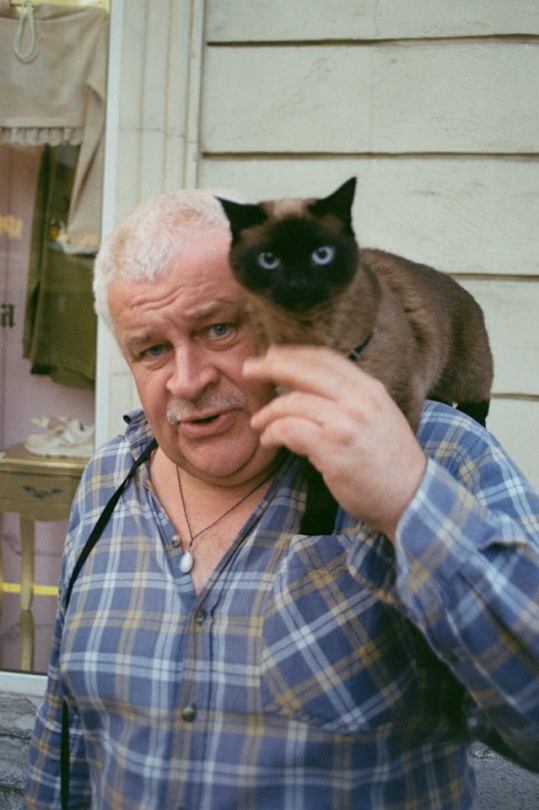
#35mm film#warsaw#street photography#portrait#street portrait#different people#ricoh#kr10 super#takumar#28mm#kodak gold 200#expired film#analog#cat#deep eyes#blue eyes#film photography#filmisnotdead#film camera#daily life
24 notes
·
View notes
Photo
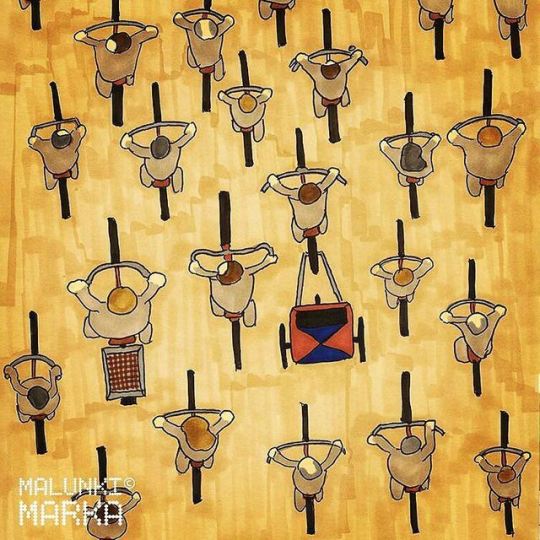
Malunki Marka @Regranned from @malunkimarka - #malunkimarka #me #inspire #painting #illustration #art #colorful #artist #painter #surreal #weird #follow #chill #warszawa #warsaw #poland #cat #colors #fun #drawing #sketch #view #beautiful #life #like #painting #cat #pattern #love #train #portrait #photooftheday
#warsaw#life#warszawa#painting#portrait#photooftheday#colorful#surreal#train#art#artist#view#love#illustration#cat#poland#colors#pattern#malunkimarka#drawing#fun#weird#beautiful#chill#me#sketch#like#follow#painter#inspire
0 notes
Text
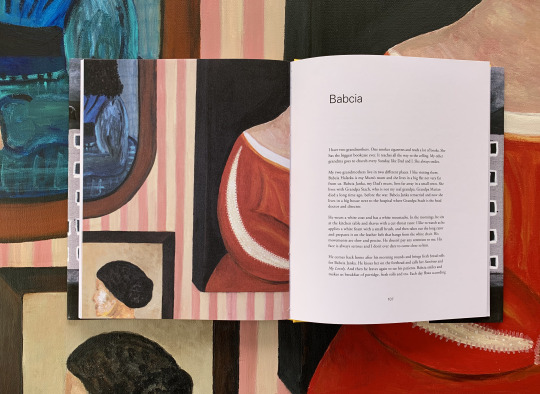
Babcia
from Patterns of Memory
I have two grandmothers. One smokes cigarettes and reads a lot of books. She has the biggest bookcase ever. It reaches all the way to the celling. My other grandma goes to church every Sunday, like Dad and I. She always smiles.
My two grandmothers live in two different places. I like visiting them. Babcia Halszka is my Mum’s mum and she lives in a big flat not very far from us. Babcia Janka, my Dad’s mum, lives far away in a small town. She lives with Grandpa Stach, who is not my real grandpa. Grandpa Marian died a long time ago, before the war. Babcia Janka remarried and now she lives in a big house next to the hospital where Grandpa Stach is the head doctor and director.
He wears a white coat and has a white moustache. In the mornings, he sits at the kitchen table and shaves with a cut-throat razor. I like to watch as he applies a white foam with a small brush, and then takes out the long razor and prepares it on the leather belt that hangs from the white chair. His movements are slow and precise. He doesn’t pay any attention to me. His face is always serious and I don’t ever dare to come close to him.
He comes back home after his morning rounds and brings fresh bread rolls for Babcia Janka. He kisses her on the forehead and calls her Sunshine and My Lovely. And then he leaves again to see his patients. Babcia smiles and makes us breakfast of porridge, fresh rolls and tea. Each day flows according to a set schedule of insulin shots, six meals, church visits, and Grandpa’s appearances. He checks regularly on her. Did you eat your lunch, Sweetie? How are you feeling today, My Dearest?
My other grandma, Babcia Halszka, is divorced and she lives alone with a greyish tabby cat named Little Kitty. The cat is a bit crazy and it bites people. It’s not little and it’s not a kitty but an old female who hates everyone but my Babcia. I’m terrified of her. I sit cross legged on a chair keeping my feet above the ground and away from Little Kitty’s sharp fangs.
After breakfast Babcia smokes and reads. She gives me a box of colour pencils and some paper to draw. The box is blue and when you open it, the wooden pencils appear in two rows. They are neatly sharpened with a knife: some shorter and some longer. Before I start drawing, I like to rearrange them according to colour. From white and yellow to the darkest black. I wish I could take the pencils home, but Babcia says they need to stay here so when I, or my cousin comes to visit we can both use them. That’s a pity. I don’t think Rafal even likes drawing that much.
Sometimes my two Grandmas come to visit us. Babcia Janka has to travel far so she stays with us and sleeps in the small bedroom. I like it when she comes. The three of us go to the church together. Mum stays at home so it is only Babcia, Dad and I that go. When she can’t come, she writes letters to me. She addresses the envelope to Miss Julia. I recognise her soft hand-writing straight away. She tells me about Grandpa, and about my uncle, my aunt, and my cousin. Her stories are full of small details which makes me miss her more. The description of flowers she picked up at the market, the cakes she is baking for Christmas and how my cousin Staś comes every day after school to visit and drinks an entire bottle of cold milk. I hate milk but I like reading Babcia’s letters.
Babcia Halszka sometimes comes over for Sunday dinner. She doesn’t go to church, like Mum. She arrives in a taxi and slowly climbs the stairs to the fourth floor where our dog Filip greets her with loud cries of adoration. He will not leave her side begging for attention, which she gives him willingly and in abundance. She sits down in the red arm chair and while catching her breath, she digs through her round handbag until she pulls out a small dark chocolate bar, which she hands to me. After dinner. She looks at me and asks for an ashtray. She is wearing red lipstick and a polka dot dress with round collar.
I run to the kitchen and I bring a small metal ashtray. She is sitting back in the armchair and the dog is trying to climb on her lap. The smoke is rising above her and then hovers where a large portrait hangs on the wall. That’s a painting of another Grandmother. Her name was Babcia Pajaczkowska, which means the ‘One of Little Spiders’. Nobody can explain why she was called that. There are no spiders in the painting. Wearing a red dress, she sits with hands on her lap and an elegant half smile. Her dark hair, styled neatly into a round bun, blends with the black background which surrounds her stiffly upright body. She is very pretty.
Babcia Pajaczkowska hangs proudly without a frame, looking at us from her past life. I wonder what kind of grandma she was. She lived a long time ago and nobody can tell me much about her, besides her strange name. Next to her, there is a portrait of Grandma Blue. She was my Dad’s Babcia. Her real name was different but she was called Babcia Niebieska because of her unusually blue eyes. Below her, there is small portrait painted by the husband of Grandma Blue’s sister. It’s a profile of a woman and I’m not sure if she is someone’s Babcia. They are all family from my Dad’s side.
Babcia Halszka’s house has more photographs than paintings. Many of them stand in neat rows on the shelf above Grandma’s bed. Her father, my great- father Otton, in a smart officer uniform, leads the collection of the family gallery. Faces in small and big wooden frames, are looking at me attentively. Grandma Maryna, Otton’s parents, Babcia’s brother Wacek, my Mum as a little girl with her sister. Black and white, and faded sepia portraits bring back stories which Babcia likes to tell me while lying on her bed and smoking.
I often ask about Jurek. He was Grandma’s youngest brother who got killed in the war. Next to the family photos, there are five old teddy bears that belonged to Jurek. They sit together from largest, the General, to the smallest, the Little Princess. They are not for playing. Only for looking.
Before the war, Jurek had a large collection of over sixty teddy bears and he created a Bear Country with its own government, laws and he even published his own newspaper. When Warsaw was under German attack, the house we lived in, was hit by a bomb which sliced the building in half. Our flat was on the second floor and it went from one side of the building, all around it, to the other side. A long hallway connected both sides. As children we used to ride our bicycles there. But after the bomb hit the building, there was a massive hole that destroyed the hallway and you couldn’t cross to the other part of the flat. Jurek’s room was separated and we couldn’t access it. All his bears were there. Grandma Maryna was the most distraught. It was after Jurek was killed and she couldn’t accept that his bears would be lost as well. Someone had to try to climb up the back staircase and rescue the bears. But it was easier said than done, as part of the back staircase was destroyed, too.
I try to imagine a building with a hole in the middle.
Who went up there? Uncle Wacek?
No, it was only us women. My brother, Wacek, was hiding somewhere in the forest with the resistance. So somehow Babcia Maryna and I climbed up there and managed to bring back five bears. We couldn’t carry more. Jurek’s room was partially burned, so that’s all we could rescue.
I look up at the shelf where they now sit. The General is dressed in a faded jacket and black trousers. His fur is very thin, in some places non-existent. Next to him, a large bear with one leg and one arm leans into another bear. That one misses both ears. The forth one is medium size. His stiff body is covered with a light fabric which has faded into different shades of grey. Last is the Little Princess, dressed in a blue skirt which clearly comes from some other doll. I wish I could dress her in something nicer. Her left leg is missing.
For now, I take care of Jurek’s bears. They are old and they keep me company. I’m old as well. But one day, they will be yours.
Ⓒ Kwinto 2021
0 notes
Text
SUMMARIZING POST
1. Evidence for completion of CAS project.
CAS PROJECT: Graffiti painting dedicated to Warsowian healthcare workers.
Link 1: https://olaaacasblog.tumblr.com/post/640606887659880448/cas-project
Link 2: https://olaaacasblog.tumblr.com/post/643136380631973888/cas-project
Link 3: https://olaaacasblog.tumblr.com/post/644311174995968000/cas-project
Link 4: https://olaaacasblog.tumblr.com/post/644311582750474240/cas-project
Link 5: https://olaaacasblog.tumblr.com/post/644312489925984256/cas-project
2. Evidence of identification of strengths and areas for personal growth (LO1).
Runner’s Cross Train Workout: https://olaaacasblog.tumblr.com/post/644311958490890240/activity
Ice skating training: https://olaaacasblog.tumblr.com/post/184877644917/activity
3. Evidence of undertaking new challenges and developing new skills in the process (LO2).
Recovery from a fail in painting: https://olaaacasblog.tumblr.com/post/619589380734124033/creativity
The morning stroll: https://olaaacasblog.tumblr.com/post/619589460619870208/activity
4. Evidence of initiating and planning a CAS experience (LO3).
The creation of self-portrait: https://olaaacasblog.tumblr.com/post/619303347269386240/creativity
The brainstorm and initiation of planning for the CAS project: https://olaaacasblog.tumblr.com/post/640606887659880448/cas-project
5. Evidence of commitment and perseverance in CAS experiences (LO4).
Learning numbers in French: https://olaaacasblog.tumblr.com/post/190608524037/creativity
Ice Skating Training: https://olaaacasblog.tumblr.com/post/182162172872/activity
6. Evidence of demonstrating the skills and recognizing the benefits of working collaboratively (LO5).
The Christmas creative workshop: https://olaaacasblog.tumblr.com/post/190630585042/service
School Debates-Warsaw: https://olaaacasblog.tumblr.com/post/179276165802/creativity
7. Evidence of engagement with issues of global significance (LO6).
Discussion on the effect of deforestation on the environment’s fauna (Animal Rights Faculty): https://olaaacasblog.tumblr.com/post/638978458862682112/service
The painting of a stray cat (Drawing and Painting): https://olaaacasblog.tumblr.com/post/182400137432/creativity
8. Evidence of recognizing and considering the ethics of choices and actions (LO7).
Prisoners Dillema (Introduction to Psychology Course): https://olaaacasblog.tumblr.com/post/638978602278518784/creativity
Discussion on animal shelters (Animal Rights Faculty): https://olaaacasblog.tumblr.com/post/644311984996859904/service
9. Evidence of reflection on significant CAS experiences.
Creativity: https://olaaacasblog.tumblr.com/post/619588375679303680/creativity
Activity: https://olaaacasblog.tumblr.com/post/619303565703380992/activity
Service: https://olaaacasblog.tumblr.com/post/619588333980483584/service
0 notes
Photo
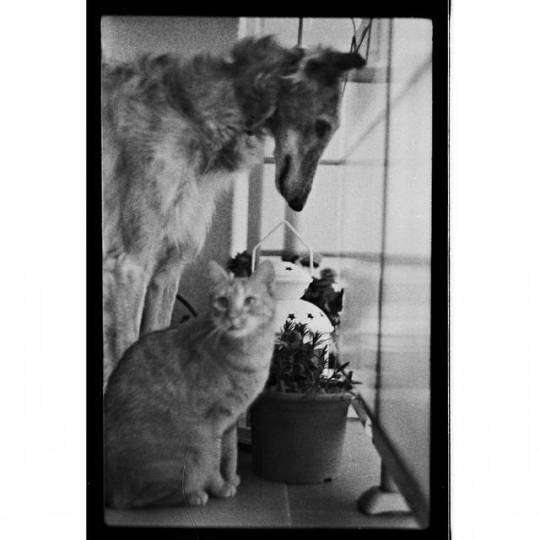
friendship #doggo #cat #animals #puppies #35mm #canonprima #animallovers #portrait #analoguelife #instaphoto #photooftheday #polishphotographer #warsaw #poland🇵🇱 (w: Warsaw, Poland)
#puppies#animals#canonprima#35mm#polishphotographer#portrait#warsaw#animallovers#instaphoto#photooftheday#poland🇵🇱#cat#analoguelife#doggo
0 notes
Photo

I've heard that at night every cats become grey...am still brown skin as I use to... #mrsprue #nasdrowie #tchintchin #sauvignonblanc #chill #night #cheers #blackwoman #warsaw #poland #lifestyle #mylife #lifestyleblogger #whitewine #black #inspire #inspiration #portrait #africanwoman #queen #quiettime (à Warsaw, Poland) https://www.instagram.com/p/B1Mm1wcobqd/?igshid=1dj1n5xzr5g8i
#mrsprue#nasdrowie#tchintchin#sauvignonblanc#chill#night#cheers#blackwoman#warsaw#poland#lifestyle#mylife#lifestyleblogger#whitewine#black#inspire#inspiration#portrait#africanwoman#queen#quiettime
0 notes
Text

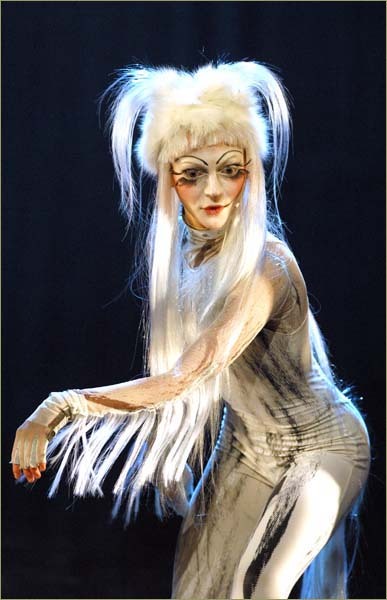
Natalia Maria Wojciechowska as Wiktoria [Victoria]
Cats Warsaw 2004
x
#cats the musical#cats warsaw#koty musical#wiktoria koty#victoria cats#natalia maria wojciechowska#cats non replica#cats warsaw portraits
33 notes
·
View notes
Text
It's 1 am, jan 10, so officially Warsaw's 20th anniversary (and mine 3rd of being in the fandom) and ofc Warsaw gotta Warsaw and i just found a few photos i have never seen before
And i learned that where was a fucking calendar made, seemingly as merch, with photos of characters and cats for each month
And what photos you may ask? The character photos from the book, or at least the one page of the calendar i found is of Demeter and it is her book portrait
But there is 15 of those photos (although idk if i should count Skimble since his isn't from a photoshoot) so now i'm wondering if how they were spread out and if any of those 15 were not included
(There is a chance it wasn't a Cats calendar but more of Roma's musicals in general but idk if they would use a portrait of one of the characters instead of a group photo or smth)
#honestly if it was cats only calendar then it makes sense they made it cuz permiere in early january#I wish i could get my hands on that calendar#and poster and umbrella and pen and mug#the chances for that are like 0#but i'll keep wishing#cats the musical#cats warsaw#warsaw guy talks
3 notes
·
View notes
Video
Profile of the male lion by Tambako The Jaguar
Via Flickr:
#lion#big#wild#cat#male#close#portrait#face#profile#standing#posing#calm#attentive#grass#vegetation#warsaw#zoo#poland#nikon#d5
40 notes
·
View notes
Photo

Magnitizdat: Soviet Aligned Pop and New Wave
Mix seven of seven. The previous mixes can be found here. The YouTube playlist for this mix can be found here. Below this paragraph is the tracklisting for this mix; below that are my notes on it. It’s been a gas.
Bravo, “Koshki”
Klaus Mitffoch, “Jezu jak się cieszę”
Spenót, “Szamba”
Tango, “Na šikmé ploše”
Forum, “Davayte sozvonimsya”
Urszula, “Wielki odlot”
Pankow, “Rock ‘n’ Roll im Stadtpark”
Florian din Transilvania, “Mă simt minunat”
Trick, “Elektronnoto kuche”
Dzeltenie Pastnieki, “Sliekutēva vaļasprieks”
Marika Gombitová, “Prekážky dní”
Grazhdanskaya Oborona, “Zoopark”
Gigi, “Divat a fontos”
Maanam, “Lucciola”
Silly, “Die Gräfin”
Kino, “Posledniy geroy”
Sfinx, “An după an”
Első Emelet, “Amerika”
Aya RL, “Skóra”
OK Band, “Žižkovská zeď”
Nastya, “Tatsu”
Magnitizdat: soviet aligned pop and new wave
In a just world, just about every nation represented here would get its own mix: Poland, Hungary, Czechia, and Russia, to name just the largest pop scenes, were (and are) too capacious to be summed up in the paltry handful of songs I’ve allotted them. But I’m already teetering on the furthest outside edge of my understanding. My grasp of Europe is comparable to Saul Steinberg’s legendary view from 9th Avenue: the further East of the Pyrenees I get the more featureless and notional everything is.
To make things more complicated, although the seven nations (at the time; now 13½) represented in this mix were formally Soviet-aligned in terms of foreign policy and general economic structure, they all pursued different approaches to cultural policy, and those policies changed radically over the decades, and even from year to year. At the beginning of the 1980s, the Soviet Union was perhaps the most officially censorious in terms of rejecting Western influence, whereas places like Poland, Hungary, East Germany, and Czechoslovakia were relatively open to current trends in Western European culture, especially following the Prague Spring of 1968. Then too, one of the necessary preconditions for good pop is money (which doesn’t necessarily mean pure capitalism: state-funded arts education and broadcast media, e.g., made British pop the envy of the world), and many of the Eastern Bloc nations, whether or not they were eager to support international-style pop, were among the poorest in Europe.
Still, life finds a way. Electronic music in particular was taken up enthusiastically by many Warsaw Pact composers in the 1970s, both as a technical challenge and as a path forward into a Communist musical future that owed nothing to the dead traditions of the West. Young musicians in Warsaw, Riga, and Leningrad got hold of contraband records or reel-to-reel tapes (called magnitizdat in Russian, in parallel with printed samizdat, according to Wikipedia) of new and innovative forms of rock and pop, imitated them, and added their own perspectives. And Eastern European nations held their own national and international versions of Eurovision, and broadcast local singers in a variety of traditions, both as light entertainment and as a way to reinforce cultural nationalism.
So although Eastern Bloc pop in the 1980s was often cheaper and perhaps chintzier (or at least dedicated to different notions of cool) than its Western counterparts, there was still plenty of it; but it was also unevenly distributed. My division below is less about population size or global importance (either today or historically) than about what would fit into a single mix. There are six Soviet songs (five Russian, one Latvian), four Polish, three Hungarian, two East German, two Czech, one Slovak, two Romanian, and one Bulgarian. Linguistically, it’s my most diverse mix by far, with six Slavic languages, one Germanic, one Uralic, and one Romance language represented (the runner-up, Melodier, had five Germanic languages and one Uralic). Google Translate is my everything.
All of them are great songs, and most of them are great records as well (we’ll get to the exception), although I doubt anyone actually living in Eastern Europe, either at the time or presently, would group together these precise performers in this way: some were defiantly underground, some boringly mainstream, and most somewhere in the middle.
Most of these mixes have taken 1981 and 1987 as the boundary years: while this one ends with a longish 1987 track as per tradition, the rest of the songs are mostly clustered between 1983 and 1985. Due to protectionist policies (both Eastern and Western), inefficiencies of resource allocation, and the slow-to-arrive effects of glasnost, the new wave (if that’s even a useful term to describe a shift towards 1980s-era modernity in the diverse Communist scenes) rolled over Eastern Europe several years after it had blanketed the West. My early investigations all centered on 1984, and further research still marks that as a pivotal year.
Anyway, here’s what I’ve fallen in love with. I hope you dig it too.
1. Bravo Koshki
no label | Moscow, 1985
WIth all apologies to Long Island’s Stray Cats, Southern California’s Blasters, England’s Shakin’ Stevens, West Germany’s Ace Cats, and Barcelona’s Loquillo, the greatest rockabilly revival act of the 1980s was the Russian Браво (Bravo). Formed in 1983 by guitarist Evgeny Havtan, with singer Zhanna Aguzarova signing on later that year, they played 1950s rock and roll with a side order of 1960s ska, with lyrics simple and catchy enough to be universal but subversive enough to get them into trouble. “Кошки” (Cats) could be a children’s song: “Cats don’t look like people, cats are cats,” is the opening lyric. But when Aguzarova adds that cats don’t talk nonsense or care about bits of paper, that’s questionable, and when she launches into some of the most thrilling scatting ever heard in rock & roll it’s downright revolutionary. After the band had self-released their first recordings on magnetic tape, she was arrested for using forged identity papers in 1984, and didn’t release a proper record until 1987. She left the band in 1989 for a solo career, and is beloved throughout Russia as a sort of Lady Gaga avant la lettre, while Bravo under Havtan and a succession of singers has continued to plow their rockabilly furrow to slightly diminished success.
2. Klaus Mitffoch Jezu jak się cieszę
Tonpress | Wrocław, 1983
One of the most important Polish new wave bands, Klaus Mitffoch combined punk energy, two-tone nimbleness, and post-punk solemnity in a compulsively listenable and sometimes danceable mix. Their first single, Jezu jak się cieszę (Jesus, I’m Happy; the name is an interjection rather than an address) is a mordant portrait of callow youth that doesn’t think past the next payday, fight, or fuck, and of the system that keeps them that way: the shouty chorus translates as “Get up and be busy and own things/I can’t really do it/I don’t really want to.” A Polish “I prefer not to,” it’s a critique of the capitalist contract which worked just as well as a critique of Communist expectations: the lack of real difference between the oppressiveness of East and West will be an ongoing theme.
3. Spenót Szamba
Start | Budapest, 1983
Although I’ve been attaching the tag “new wave” to these mixes, one of the signature sounds of the US new wave has been entirely unrepresented: the beachy kitsch of the B-52’s. Until now. Spenót (Spinach) was a Budapest arts collective founded in the early 80s which only released one single on the rock imprint of the Hungarian state label: “Szamba” (Samba) b/w “Hová tűntek a szőke nőket” (Where Did the Blondes Go). Casio, bass, guitar, and disaffected vocals from Kriszta Berzsenyi (now a costumer in the Hungarian film industry) make for a minimal-funk tribute to proletarian hero Popeye, as the refrain “Everything’s perfectly fine, I’ve got spinach flowing in my veins” makes clear. A late entrance from a mariachi trumpet only adds to the delightful kitsch effect, and makes me grin ear to ear every time I listen.
4. Tango Na šikmé ploše
Supraphon | Prague, 1984
Although the island-borrowed rhythms and frontman Miroslav Imrich’s vocal qualities in this early song are rather heavily reminiscent of the Police, in terms of cultural positioning Tango were rather closer to Madness: a ska-pop band that could be goofy or heartfelt depending on the song, and burrowed deep into Czech working-class cultural identity, in part thanks to their inventive and prolific videos. Their first single, “Na šikmé ploše” (On the Slope) is a heartfelt and rather poetic love song on skis. Even after Tango’s dissolution, Imrich has been a consistently popular singer and songwriter in the years since, his work, both solo and in collaboration, ranging from ballads to techno.
5. Forum Davayte sozvonimsya
no label | Moscow, 1984
A Russian synthpop band who owed nothing to such English decadents as Human League or Depeche Mode, Форум was fronted by singer Viktor Saltykov, who had previously sung with rock band Manufactura, and anchored by synth wizard Alexander Morozov. The video for Давайте созвонимся (Let’s Call Each Other), from an early television appearance, has become a minor internet classic of kitschy Soviet aesthetics, but a google of the lyrics reveals as thoughtful and sensitive a song about love under modern technological conditions as anything Gary Numan or Scritti Politti ever recorded. Forum’s debut album wouldn’t see official release until 1987, by which time a lot of Russian pop had caught up to them.
6. Urszula Wielki odlot
Polton | Lublin, 1984
Perhaps Poland’s most prominent female rock star for the last forty years, Urszula Kasprzak has recorded in a variety of styles, from hard rock to dance-pop; but her 1984 album Malinowy król (Raspberry King), recorded with members of prog band Budka Suflera, is a minor masterpiece of cool, reflective synthpop. “Wielki odlot” (The Great Departure) was the leadoff track and the album’s lowest-charting single, but I love its stately swell and the apocalyptic lyrics (or maybe it’s just about emigration, which is another form of apocalypse). I’m looking forward into digging around into the rest of Urszula’s discography.
7. Pankow Rock ’n’ Roll im Stadtpark
AMIGA | Berlin, 1983
East Germany probably had the most thoroughly Westernized and extensive pop scene in the whole Eastern Bloc — only natural, given its proximity and exposure to West German media. But child star Nina Hagen had to leave East Berlin to help found the Neue Deutsche Welle: East Germany preferred shaggy 70s rock even as icy synths overran the NATO countries. Pankow, formed in the eponymous suburb of East Berlin, was a case in point: definitely a new wave band, they still clearly adored old-fashioned boogie rock. “Rock ’n’ Roll im Stadtpark” (Rock ’n’ Roll in the City Park) is an anthem of Communist rock (even the shouted refrains are collectivized): dancing to rock & roll in the park is better than bourgeois disco or high-priced cinema, because it’s free. Of the people, by the people, for the people, oh yeah.
8. Florian din Transilvania Mă simt minunat
Electrecord | Bucharest, 1986
The hermetic and impoverished Romanian scene, tightly controlled by Nicolae Ceaușescu’s Maoist-modeled authoritarian government, was the slowest of the European Communist nations to catch up to the present of the 1980s: officially supported music tended to be folkloric, balladic, and at its most up-to-date, hippie-era hard rock. Mircea Florian was one of the grand exceptions: beginning as a mid-60s folk-rocker in the mold of Dylan and Cohen, and maintaining a parallel interest in electronics and modern composers like Stockhausen and Nono, he moved through many progressive, electric, and Eastern-influenced musical phases over the next twenty years, often butting heads with the regime. His last great record, 1986’s Tainicul vîrtej (The Secret Swirl), released just before his defection to West Germany, was a summation of his folk- and art-rock past and his new-wave present. This opening track “I Feel Great,” is a statement of gleeful modernism, the lyrics an expression of bucolic alienation while the synthesizers and drum machines wander off on prog-rock solos before being recalled to robot rhythms.
9. Trick Elektronnoto kuche
Balkanton | Sofia, 1985
If the Romanian rock scene was impoverished, its Bulgarian counterpart was even more so. Trick was a vocal group — two women, one man — put together out of music school in frank imitation of Western acts like ABBA, Boney M, or even (if the record sleeves are any indication) Tony Orlando and Dawn. But this cut from their first LP, “Electronic Dog,” was produced by the young, ambitious Kristian Boyadzhiev to a hypermodern sheen: if the girls are still essentially singing disco harmonies, at least the music has heard of ZTT. After release, the song was suppressed by Bulgarian state media on the grounds that the goofy lyrics and synthesized dog barks were making a mockery of Bulgarian electronics. But today, it sounds like it might predict Eastern European trance.
10. Dzeltenie Pastnieki Sliekutēva vaļasprieks
no label | Riga, 1984
The underground new-wave scene in Latvia was apparently the most active and prolific in the Soviet Union outside Mother Russia: the Baltic seaport of Riga, as one of the USSR’s few access points to global culture, saw bands like Pērkons, NSRD, and Dzeltenie Pastnieki making waves even as their magnetic-tape recordings were suppressed by the Soviet authorities and not released for decades. I chose this song by Dzeltenie Pastnieki (Yellow Postmen) not because it’s exceptionally better than the rest of their material, which is all pretty great, but because its combination of electronic loops and sensitive guitar sounded surprisingly to me like the Postal Service. The pitch-shifted vocals, sure, sound more like “The Laughing Gnome,” but that’s no deal-breaker.
11. Marika Gombitová Prekážky dní
Opus | Bratislava, 1984
Probably the biggest Slovak pop star of the era, Marika Gombitová had been well-known in the eastern half of Czechoslovakia since 1977, when she sang leads for the popular rock band Modus. This synthpop gem (Daily Obstacles) from her fifth album, the unselfconsciously-titled No. 5 (it was her first stab at singing to synthesizers), uses sporting metaphors to talk about desires that slip forever out of reach, the evocativeness of which imagery would not have been lost on a contemporary television-watching audience: Gombitová had been confined to a wheelchair, paralyzed from the shoulders down, following a car crash in 1981. Her marvelous voice, thin but strong, reminds me of Cyndi Lauper’s: and the gorgeous production, with its slippery bass and a haunting electronic solo in the middle eight, makes this maybe my favorite song in this mix.
12. Grazhdanskaya Oborona Zoopark
no label | Omsk, 1985
Here’s that not-great record, meaning only that it’s extremely lo-fi, so much so that the tape hiss and room tone plays practically an aesthetic role, turning a simple rock ballad into a fuzz-pop gem that could sit side-by-side with contemporary work by the Beat Happening or Hüsker Dü. Гражданская Оборона (Civil Defense) was the psych-rock project of Siberian-born Yegor Letov; after their first magnetic tape, containing “зоопарк,” was recorded, band members were institutionalized, their subversive attitudes having been dutifully reported to the authorities by the guitarist's mother. That subversiveness isn’t hard to detect in this song, in which Letov dreams of finding other crazy people (like him) with whom he can plot an escape from the zoo of contemporary life.
13. Gigi Divat a fontos
Start | Budapest, 1985
Nobody on the Internet seems to know anything about Gigi, not even whether the name is of a performer or a group. The writing credit on the Hungarian compilation LP where “Divat a fontos” (Fashion Matters) appeared is to “Gigi Együttes,” which latter word just means Ensemble. But a bunch of people on the Internet, some in Hungarian, some in English, and some in Polish, have warmly praised this song, an aerobic synthpop jam that combines the best of Kim Wilde and Olivia Newton-John. It’s apparently all that this Gigi (the thirty-first entity of that name on Discogs) ever recorded, but it’s enough.
14. Maanam Lucciola
Polskie Nagrania Muza | Kraków, 1984
The post-punk band Maanam, on the other hand, are legends of Polish rock, with dozens of records and a rabid fanbase: one of the most successful and important Eastern European bands of the decade. Lead singer Kora (Olga Jackowska)’s vocal style owed little to Anglophone precedent, digging deep into Slavic and Polish modernism, even when, as here, the most frequent word in the song is the Italian woman’s name of the title. In “Lucciola,” Kora dispassionately portrays a man searching for the titular woman in the night wind, while the band’s brawny Gang of Four funk motorvates right along regardless.
15. Silly Die Gräfin
AMIGA | Berlin, 1982
Probably the most interesting East German rock band of the 1980s, Silly was centered around the vocal performances of Tamara Danz, who could be kabarett-outrageous in one song and luminously synthpop-tender in the next. “Die Gräfin” (lit. The Countess, but also slang for any stuck-up woman) is a funk-rock vehicle for her gift for satirical vocal caricature, as she mocks the decayed German aristocracy from a victorious proletarian point of view. Not that Danz was a strict ideologue: in 1989, she joined other East German musicians in demanding greater freedom, in protests that helped lead to the collapse of the Communist consensus. She died in 1996 of breast cancer, far too young.
16. Kino Posledniy geroy
AnTrop | Leningrad, 1984
The only Russian band represented on this mix whose music was officially released within the era under consideration, Кино (Cinema) were no less skeptical about the Soviet system than their peers, just luckier in that they hooked up with the independent Leningrad-based AnTrop label, which gave them cover for sarcastic, despairing songs like ��оследний герой (Last of the Heroes), in which the familiar 80s theme of nuclear annihilation gets another airing, and East and West turn out to be not so different after all.
17. Sfinx An după an
Electrecord | Bucharest, 1984
When Mircea Florian was one of the leading lights of Romanian prog in the 1970s, one of his few competitors in the field was the band Sfinx (Sphinx), formed in the mid-60s to play Western-style pop/rock. In the following decade, they grew more ambitious, taking cues from Yes, King Crimson, and Genesis, the last of whom, in their 80s incarnation, is a reference point here. “An după an” means Year After Year, and even though it was only their second LP (they were constantly running afoul of the Romanian censors), it was occasion for a wistful look back over the last twenty years.
18. Első Emelet Amerika
Start | Budapest, 1983
Perhaps the most popular Hungarian rock band of the early 80s, Első Emelet (First Floor) was formed from the remnants of several less fortunate acts which imploded around 1982. With a bright, energetic sound, witty lyrics by songwriter Péter Geszti, and an irreverent comic sensibility to their visual presentation, they were just the kind of band that would have been a lock to appear on MTV if they weren’t from a Communist nation. In fact, they did anyway — one of the television screens in Dire Straits’ “Money for Nothing” is playing an Első Emelet video. Their first single, “Amerika” is a terrific satire of that consumerist paradise, rendered with all the plastic pomp the subject deserve.
19. Aya RL Skóra
Tonpress | Warsaw, 1984
One of the greatest long-running European indie-rock bands, Aya RL (for Red Love) formed when Russian keyboardist Igor Czerniawski and Polish singer Paweł Kukiz met in Warsaw. “Skóra” (Skin), their biggest hit and most well-loved song (I dare you to get that wordless chorus out of your head), is somewhat unrepresentative of their more psychedelic and intellectual work — but it’s a great song, a portrait of love despite the turmoil and violence of the heavily politicized street culture of Warsaw in the 1980s.
20. OK Band Žižkovská zeď
Supraphon | Prague, 1982
If you didn’t know anything about Eastern Bloc music in the 1980s and relied only on what the Western media of the time showed you, you might expect it all to sound like this: icy, measured, foreboding. In fact, “Žižkovská zeď” (The Zizkov Wall) is just about the slowest and coldest song in Czech synthpop act OK Band’s repertoire: most of it is much cheerier and romantic. But I really dig its coldwave vibes and the sound of Marcela Březinová’s voice singing about the awful feeling of seeing your name written in graffiti by an unknown hand.
21. Nastya Tatsu
no label | Sverdlovsk, 1987
Thanks no doubt to my own global position — in the (allegedly) democratic West — I’ve been focused throughout this mix on how the music of Communist Europe responds to or relates to or recalls its Western counterparts. But with “Tatsu,” the gaze shifts not West, but East. Nastya, a band formed on the border of Europe and Asia, and named after its frontwoman, singer, composer and poet Anastasia Polova, was fascinated with Japanese folklore, history, and mythology. The Tatsu of the title is both a Japanese child left for dead in World War II (that’s where the bits in English come in), and a mythological dragon-god protecting islands in the Pacific. It’s an amazing song, the centerpiece of an amazing album, and the fact that it only circulated as a bootleg tape for a decade before being officially issued in the mid-90s is the strongest indictment of late-Soviet cultural policy I know. I say that as a Communist.
That’s it, that’s all the mixes. For now, anyway. Thanks for reading and listening and sharing and liking. I’ve got other projects to keep me busy; I’ll try to mention them here from time to time.
15 notes
·
View notes
Photo
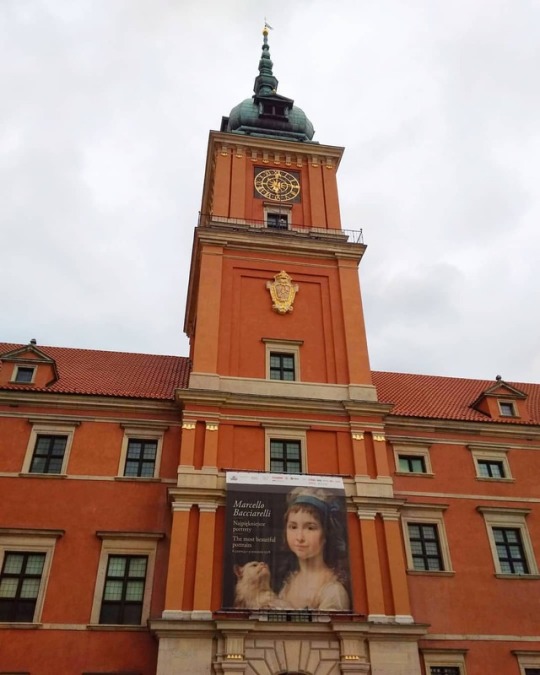
🐈Итальянец Марчелло Баччарелли, по приказу короля Станислава Августа, разрабатывал проект создания в ВАРШАВЕ Академии изящных искусств. Но трудности столь серьезной профессии не мешали ему быть на волне модных тенденций и рисовать портреты дам с КОТИКАМИ (пусть будет и для конкурса @insta_fabrika #игры_блогеров). Например, на этом - кошка, кажется, не в восторге от компании Юлии Духамель, дочери королевского секретаря. . 🐈🇬🇧 The Italian Marcello Bacciarelli, on the orders of King Stanislav Augustus, was developing a project for the creation of the Academy of Fine Arts in WARSAW. And he was on the wave of fashion trends drawing portraits of women with CATS) For example, here you can see Julia Duhamel, daughter of the royal secretary. . 🐈🇵🇱 Włoski artysta Marcello Bacciarelli, na polecenie króla Stanisława Augusta, opracował projekt utworzenia Akademii Sztuk Pięknych w WARSZAWIE. Ale to nie przeszkadzało mu być na fali trendów mody i rysować portrety kobiet z KOTAMI). Jak Julia Duhamel, córka królewskiego sekretarza. . 🐱 #pasiyakas_cats 🐱 🐱🐱 #pasiyakas_poland 🐱🐱 . #travel #trip #travelblogger #travelgram #instatravel #instatrip #poland #polska #polish #warsaw #warszawa #warszawa_love #warsawnow #warsawgirl #placzamkowy #cats #catsgram #catlover #котики #portrait #портрет (at Zamek Królewski w Warszawie) https://www.instagram.com/p/BukvjJ0Fls2/?utm_source=ig_tumblr_share&igshid=wzkmr8q905uz
#игры_блогеров#pasiyakas_cats#pasiyakas_poland#travel#trip#travelblogger#travelgram#instatravel#instatrip#poland#polska#polish#warsaw#warszawa#warszawa_love#warsawnow#warsawgirl#placzamkowy#cats#catsgram#catlover#котики#portrait#портрет
0 notes

